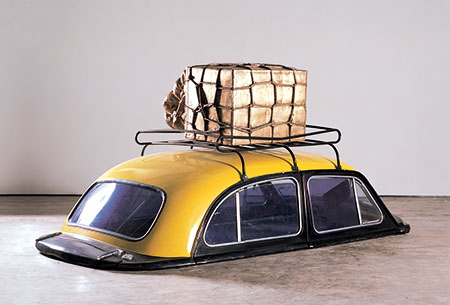Loaded Vehicle
How the iconic, discontinued Ambassador car has inspired Indian artists
How the iconic, discontinued Ambassador car has inspired Indian artists

In 2014, Hindustan Motors announced that it was suspending production of the Ambassador, citing ‘low productivity, growing indiscipline [at its Uttapara plant], critical shortage of funds, lack of demand for its core product’. Fondly referred to as the ‘Amby’ and modelled on the British Morris Oxford, the Ambassador was the first car to be made in independent India, in 1957. In the 1960s and ’70s, the country’s protectionist economy ensured the car’s omnipresence. Used by the affluent and by government officials, the Ambassador was a status symbol. It was only in the mid-1980s, when Maruti Suzuki entered the Indian market with the cheaper Alto model, that the Amby’s sales started to decline.
In recent years, the Amby – which resembles a bowler hat and can accommodate six passengers – has been fetishized. Next to the sleek automobiles of today, its high seats, large boot and generous headroom have too easily become a symbol of socialist-era nostalgia. However, not everyone is mourning the car’s demise. Hormazd Sorabjee, the editor of Autocar India, pointed out recently that it represented ‘all that was wrong with India’s controlled economy […] Carmakers could not increase prices or make more cars without the government’s approval […] buyers were saddled with cars of appalling quality, which constantly broke down.’
A number of contemporary Indian artists whose work deals with issues around mobility and migration have dwelt on the emblematic power of the Ambassador. It recurs in many of Subodh Gupta’s paintings and sculptures, most expressively in Everything is Inside (2004), which comprises the sliced-off top of an Amby, weighed down by parcels, tightly wrapped in string and cast in bronze. The sculpture is a visceral enactment of the subcontinent’s shifting economic patterns: the car sinks into the ground, overwhelmed by the possessions brought back by migrant workers who are now part of a new global order of capital.
Courtesy of the Ambassador, Vipin Vijay’s ruminations on transience, memory and mortality come alive in Video Game (2007). Full of disparate images, the film is structured around footage shot on a road trip through Purulia in West Bengal, and considers the car less as a means of transportation than as a way of establishing a perspective on the impact that evolving technology has on places and people. It was inspired by the tragicomic 1958 film Ajantrik by Bengali filmmaker Ritwik Ghatak, which focuses on a taxi driver’s dedication to his 30-year-old Chevrolet jalopy. Ajantrik is a moving exploration of human attachment and the demands and difficulties of adapting to evolving technologies.
However, it was the late Raghubir Singh who produced the most remarkable record of the Ambassador with his posthumously published photobook A Way into India (2002). Singh was born into a family of Jaipur landowners, whose feudal way of life came to an end with Indian independence. By the mid-1960s, Singh was a freelance photographer for Life, The New York Times and National Geographic. Gradually shifting away from photojournalism, he began creating his own books in the 1970s. Unusually for the time, he shot in Kodachrome, which was neither available nor processed in India.
In A Way into India, Singh used the Ambassador car not only as a subject in plentiful commonplace narratives, differing in colour and condition, but also as ‘as a camera, a big black box with windows’. The earliest image in the book dates from 1977, suggesting that his interest in the Ambassador had been a long-standing preoccupation. Over the ensuing decades, until his death in 1999, Singh employed the car as a metaphor, its contours and curves reflecting, obscuring and shaping the rapidly transforming geography of India. The images in A Way into India belie an appreciation of flux and impermanence, and one of Singh’s talents is the way in which he adopts a Modernist pictorial language in order to capture the effects of a globalizing world.
Singh, who some believe to be India’s greatest photographer, declared the Ambassador to be ‘a measuring rod for end-of-century India […] a metal monument that slides into history as a part of India’s long journey […] an organic part of bird shit and cow dung-coated India. It is the good and bad of India […] In its imperfection it is truly an Indian automobile.’ There is no better eulogy for the Amby than Singh’s enduring images.























